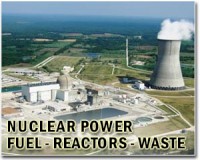 |
San Clemente, California (AFP) April 17, 2011 Year-round sunshine, beautiful beaches, a dream lifestyle: for residents near California's San Onofre atomic power plant, Japan's nuclear crisis seems a world away. Even though the area combines all the factors behind the Fukushima meltdown -- on a low-lying coast, near a major seismic faultline, and in the shadow of a water-cooled nuclear power plant -- locals here say they are not worried. "I've lived here for 22 years and there's never been a problem," said Al Parker, sunbathing on the beach in San Clemente, some 60 miles (100 km) south of Los Angeles, and six miles (10k km) from the San Onofre power plant. "There's too many things to worry about in this world. I have no concerns. This is the USA, not Japan, not Russia," he added, referring to Fukushima and 1986 Chernobyl disaster in Soviet-era Ukraine. The operators of the San Onofre plant, Southern California Edison, held a three-day drill this week to test the ability of the facility and local, state and federal agencies to respond to a radiological emergency. The simulation was long scheduled, and is required every two years, but drew more attention following the March 11 earthquake and tsunani in Japan which triggered the Fukushima nuclear crisis. "My single biggest hope out of the day is it will be reassuring to the public in the aftermath of the tragic earthquake and tsunami in Japan," said the power company's spokesman Gil Alexander afterwards. Since the late 1970s California -- which has two nuclear plants, San Onofre and another one at Diablo Canyon, on the coast north of Los Angeles -- has banned new nuclear reactors due to concerns over radioactive waste disposal. San Onofre's operators say the plant -- the same water-cooled design as Fukushima -- was built to withstand an earthquake of up to 7.0 in magnitude -- far less than the killer 9.0 temblor which hit Japan. San Onofre had its critics: in June 1980, some 15,000 people attended a protest near the plant, which now provides power to 1.4 million people in the southern Californian area. But on the ground in San Clemente, it is difficult to find anyone who disagreed with the reassuring message about San Onofre, which has been producing power since 1984. "I have lived here for 40 years, raised my children here and spend time with my eight grandchildren," said Mary Jo Conrad, co owner of Conrad and associates realtors "It is a beautiful place with great beaches, nice weather, friendly people ... We have no problem with the nuclear plant. We are in the United States, a country that is great." San Clemente is in Orange County, one of the richest areas of the US, where the average asking price for a house is over $1 dollars. President Richard Nixon bought his 'western White House' here in 1968. In Oceanside, some 15 miles (25 km) from San Onofre and near the Camp Pendleton military base, the message is the same. "I'm very religious, so it's all in God's will," said Kimberlee Brown. "I'll go when it's my time. You know, it's just nature and life. It's here for a reason. It's here to do its promising works. I'm not worried at all." Eric Nesbitt, an electrician who helped build the plant between 1979-1984, added: "I've never built something as good as that place. I like nuclear. I think that if nuclear is built properly and on a good spot, there is no risk. "And there is risk in everything. You know, this is life! That's why life is so exciting," he added. Back in San Clemente, some locals voice frustration at the number of journalists who have come here since the Japanese disaster, including for this week's emergency drill. "Honestly the nuclear plant or the risk to live here because of the possibilities of a tsunami or earthquake," said restaurateur Scott Perry, 41, with his young son playing in the sand at San Clemente beach. "I think is not an issue for our a community, its not something that is present in our lives," he added. And he adds: "How many nuclear accidents have ocurred in the last 30 years? The Three Mile Island accident (in 1979); Chernobyl, and now in Japan, just three, so I think is not something that we can say is unsafe". "I like this area ... If something like Japan happens we'll be going to Vegas, we have a place to stay there."
Share This Article With Planet Earth
Related Links Nuclear Power News - Nuclear Science, Nuclear Technology Powering The World in the 21st Century at Energy-Daily.com
 Chernobyl survivor still backs nuclear energy
Chernobyl survivor still backs nuclear energySingapore (AFP) April 16, 2011 It happened a quarter of a century ago but Sergei Belyakov still remembers vividly how much he suffered from high radiation exposure after the Chernobyl nuclear plant meltdown. "I was extremely weak, my motion senses were altered and I had difficulty breathing normally," said the Ukrainian-born scientist, part of a Soviet clean-up crew assigned to tackle the world's worst nuclear plant disas ... read more |
|
| The content herein, unless otherwise known to be public domain, are Copyright 1995-2010 - SpaceDaily. AFP and UPI Wire Stories are copyright Agence France-Presse and United Press International. ESA Portal Reports are copyright European Space Agency. All NASA sourced material is public domain. Additional copyrights may apply in whole or part to other bona fide parties. Advertising does not imply endorsement,agreement or approval of any opinions, statements or information provided by SpaceDaily on any Web page published or hosted by SpaceDaily. Privacy Statement |